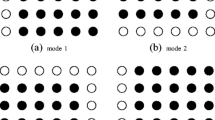Abstract
A new reversible watermark scheme based on multiple prediction modes and adaptive watermark embedding is presented. Six prediction modes fully exploiting strong correlation between any pixel and its surrounding pixels, are designed in this paper. Under any prediction mode, each to-be-predicted pixel must be surrounded by several pixels (they constitute a local neighborhood, and any modification to this neighborhood is not allowed in the embedding process). This neighborhood has three main applications. The first one is that when it is exploited to interpolate some to-be-predicted pixel, the noticeable improvement in prediction accuracy is obtained. The second one is that its variance is employed to determine which classification (i.e., smooth or complex set) its surrounded pixel belongs to. For any to-be-predicted pixel, the number of embedded bits is adaptively determined according to this pixel’s belonging. The last one is that we can accurately evaluate the classification of watermarked pixels by analyzing the local complexity of their corresponding neighborhoods on the decoding side. Therefore, the payload can be largely increased as each to-be-predicted pixel in the smooth set can possibly carry more than 1 bit. Meanwhile, the embedding distortion is greatly controlled by embedding more bits into pixels belonging to smooth set and fewer bits into the others in complex set. Experimental results reveal the proposed method is effective.












Similar content being viewed by others
References
Alattar AM (2004) Reversible watermark using the difference expansion of a generalized integer transform. IEEE Trans Image Process 13(8):1147–1156
Coltuc D, Chassery JM (2007) Very fast watermarking by reversible contrast mapping. IEEE Sig Process Lett 14(4):255–258
Gao XB, An LL (2009) Reversibility improved lossless data hiding. Signal Process 89(10):2053–2065
Honsinger CW, Jones P, Rabbani M, Stoffe JC (2001) Lossless recovery of an original image containing embedded data. US patent: 6278791
Lin WH, Horng SJ, Kao TW, Fan P, Lee CL, Pan Y (2008) An efficient watermarking method based on significant difference of wavelet coefficient quantization. IEEE Trans Multimedia 10(5):746–757
Lin W-H, Wang Y-R, Horng S-J (2009) A wavelet-tree-based watermarking method using distance vector of binary cluster. Expert Syst Appl 36(6):9869–9878
Li XL, Yang B, Zeng TY (2011) Efficient reversible watermarking based on adaptive prediction-error expansion and pixel selection. IEEE Trans Image Process 20(12):3524–3533
Luo L, Chen Z, Chen M, Zeng X, Xiong Z (2010) Reversible image watermarking using interpolation technique. IEEE Trans Inf Forensics Security 5(1):187–193
Ni ZC, Shi YQ, Ansari N, Su W, Sun QB (2008) Robust lossless image data hiding designed for semi-fragile image. IEEE Trans Circ Syst Video Tech 18(4):497–509
Peng F, Li X, Yang B (2012) Adaptive reversible data hiding scheme based on integer transform. Signal Process 92(1):54–62
Rosiyadi D, Horng S-J, Fan PZ, Wang X, Khan MK, Pan Y (2012) An efficient copyright protection scheme for e-government document images. IEEE Multimedia 19(3):62–73
Shi YQ, Ni ZC, Zou D, Liang CY, Xuan GR (2004) Lossless data hiding: fundamentals, algorithms and applications. In: Proceedings of IEEE international symposium on circuits and systems, vol 2, pp 33–36
Tian J (2003) Reversible data embedding using a difference expansion. IEEE Trans Circ Syst Video Tech 13(8):890–896
Thodi DM, Rodrguez JJ (2007) Expansion embedding techniques for reversible watermarking. IEEE Trans Image Process 16(3):721–730
Vleeschouwer C, De Delaigle JF, Macq B (2003) Circular interpretation of bijective transformations in lossless watermarking for media asset management. IEEE Trans Multimedia 5(1):97–105
Wang X, Li XL, Yang B (2010) High capacity reversible image watermarking based on in transform. In: Proceedings of ICIP
Wang X, Li XL, Yang B, Guo ZM (2010) Efficient generalized integer transform for reversible watermarking. IEEE Sig Process Lett 17(6):567–570
Weng SW, Zhao Y, Ni RR, Pan JS (2009) Parity-invariability-based reversible watermarking. IET Electron Lett 1(2):91–95
Weng SW, Zhao Y, Pan JS, Ni RR (2008) Reversible watermarking based on invariability and adjustment on pixel pairs. IEEE Sig Process Lett 45(20):1022–1023
Wu H-T, Huang JW (2012) Reversible image watermarking on prediction errors by efficient histogram modification. Signal Process 92(12):3000–3009
Wu X, Memon N (1997) Context-based, adaptive, lossless image coding. IEEE Trans Commun 45(4):437–444
Zou DK, Shi YQ, Ni ZC, Su W (2006) A semi-fragile lossless digital watermarking scheme based on integer wavelet transform. IEEE Trans Circ Syst Video Tech 16(10):1294–1300
Acknowledgement
This work was supported in part by National NSF of China (No. 61201393, No. 61272498, No. 61001179).
Author information
Authors and Affiliations
Corresponding author
Rights and permissions
About this article
Cite this article
Weng, S., Pan, JS. Reversible watermarking based on multiple prediction modes and adaptive watermark embedding. Multimed Tools Appl 72, 3063–3083 (2014). https://doi.org/10.1007/s11042-013-1585-7
Published:
Issue Date:
DOI: https://doi.org/10.1007/s11042-013-1585-7




